|
|
|
Sort Order |
|
|
|
Items / Page
|
|
|
|
|
|
|
| Srl | Item |
| 1 |
ID:
177151
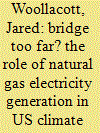

|
|
|
|
|
| Summary/Abstract |
Natural gas has been promoted as a ‘‘bridge’’ fuel toward a low-carbon future by offering near-term emissions reductions at lower cost. Existing literature is inconclusive on the short-term emissions benefits of more abundant natural gas. The long-lived nature of natural gas infrastructure also threatens to lock in emissions levels well above longer-term targets. If natural gas can offer short-to-medium term benefits, how much of a bridge should we build? Using ARTIMAS, a foresighted computable general equilibrium model of the US economy, we interact scenarios developed by the EMF-34 study group related to abundant natural gas, low-cost renewables, and a carbon tax to examine the role of natural gas in a carbon-constrained future. We find that abundant natural gas alone does not have a significant impact on CO2 emissions. We also find that, under a higher carbon tax, natural gas investment of approximately $10 billion per year declines to zero at a tax of about $40/ton and existing natural gas assets face significant risk of impairment. Last, the presence of abundant natural gas lowers the marginal welfare cost of abating small amounts of CO2 but is likely to raise the cost of abatement levels consistent with common climate objectives. The integrated welfare costs of climate policy depend on how much abatement we must undertake.
|
|
|
|
|
|
|
|
|
|
|
|
|
|
|
|
| 2 |
ID:
158914
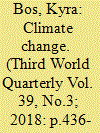

|
|
|
|
|
| Summary/Abstract |
Under the Paris Agreement, 80% of all proven fossil fuel reserves become stranded resources and investments already made in such resources turn into stranded assets. Much of the existing literature focuses on equitable burden sharing; only a few articles examine the risks for developing countries that invest in new fossil fuels. Hence, this paper addresses the question: What are the risks of investing in fossil fuels for developing countries? In doing so, it examines Kenya, a prospective fossil fuel producer, and China, an investor in fossil fuels. In terms of short- to long-term risks, ignoring new fossil fuels and investing in renewables is favourable and politically, socially, ecologically and economically more rewarding, not least because latecomers to development run the risk of having to compensate investors when new fossil fuel assets strand prematurely and become unrecoverable.
|
|
|
|
|
|
|
|
|
|
|
|
|
|
|
|
| 3 |
ID:
150744
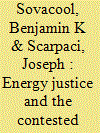

|
|
|
|
|
| Summary/Abstract |
Ecuador's progressive Yasuní-ITT Initiative, operational 2007 to 2013, would have left almost one billion barrels of crude oil locked in perpetuity beneath one of the most intact and diverse nature reserves on the planet. The project attempted to “strand” these oil assets in order to protect biodiversity, respect the territory of indigenous peoples, combat climate change, and encourage more sustainable economic development. The Yasuní-ITT proposal would have had the international community pay Ecuador $3.6 billion—roughly half the value of the oil found there—in exchange for not developing the Ishpingo Tambococha Tiputini (ITT) oilfields. Funds would have been placed into social and environmental development programs and the promotion of domestic renewable energy. Instead, the project collected only $13 million and succumbed to a series of challenges including limited financing, intense political pressure, a national commitment to oil, and carbon leakage. This article summarizes the history, benefits, and insurmountable obstacles facing the Yasuní-ITT Initiative and presents six broader lessons and implications for climate and energy analysts, practitioners, and policymakers. It questions the political viability of and serves as a stark warning against those promoting and advocating policies centered on carbon budgets, stranded assets, negative emissions, and carbon revenue streams.
|
|
|
|
|
|
|
|
|
|
|
|
|
|
|
|
| 4 |
ID:
185720
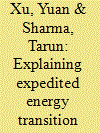

|
|
|
|
|
| Summary/Abstract |
Energy transition toward renewables, mainly wind and solar, has gained momentum in the past decade. Although the COVID-19 pandemic brought unprecedented, multi-faceted challenges and uncertainties, India witnessed an expedited energy transition in 2020. With our newly constructed Electric System Dispatch Model for India (ESDMI), this study aims to provide an explanation of the underlining mechanisms. The Janta Curfew (7am-9pm) in India was observed on March 22, 2020 followed by a 21-day complete lockdown starting March 25, 2020 to control the spread of the virus. Electricity demand in India dropped by nearly a quarter. We model the supply-side dynamics prior to and during the pandemic response as well as in a counterfactual scenario in the pandemic's absence. We find that the expedited energy transition could be explained by (i) the higher priority of a large renewables fleet to access electric grid either through stipulations and the merit order effect, and (ii) coal-fired electricity generation is less flexible than natural gas and hydropower units. A substantial amount of coal-fired power plants in India are still far from reaching their designed lifetimes. Their low resilience in such crises could exacerbate the problem of stranded assets.
|
|
|
|
|
|
|
|
|
|
|
|
|
|
|
|
| 5 |
ID:
163561
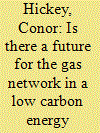

|
|
|
|
|
| Summary/Abstract |
This paper evaluates the potential low carbon opportunities for and challenges to the utilisation and financial performance of Ireland's gas distribution network within a series of low carbon scenarios. There has been a limited amount of academic literature published on the future implications of gas demand on gas networks. This paper takes the unique perspective of assessing the stranded asset risk to a utility operating a gas network in the context of a low carbon energy system. Building on established emissions reduction scenarios, a financial model is developed from an integrated energy system model to understand the financial risks associated with continued investment in gas networks. We find that higher network tariffs are required for consumers in the future to cover network costs, even though gas consumption grows relative to current consumption levels in low carbon scenarios with carbon capture and storage.
|
|
|
|
|
|
|
|
|
|
|
|
|
|
|
|
|
|
|
|
|